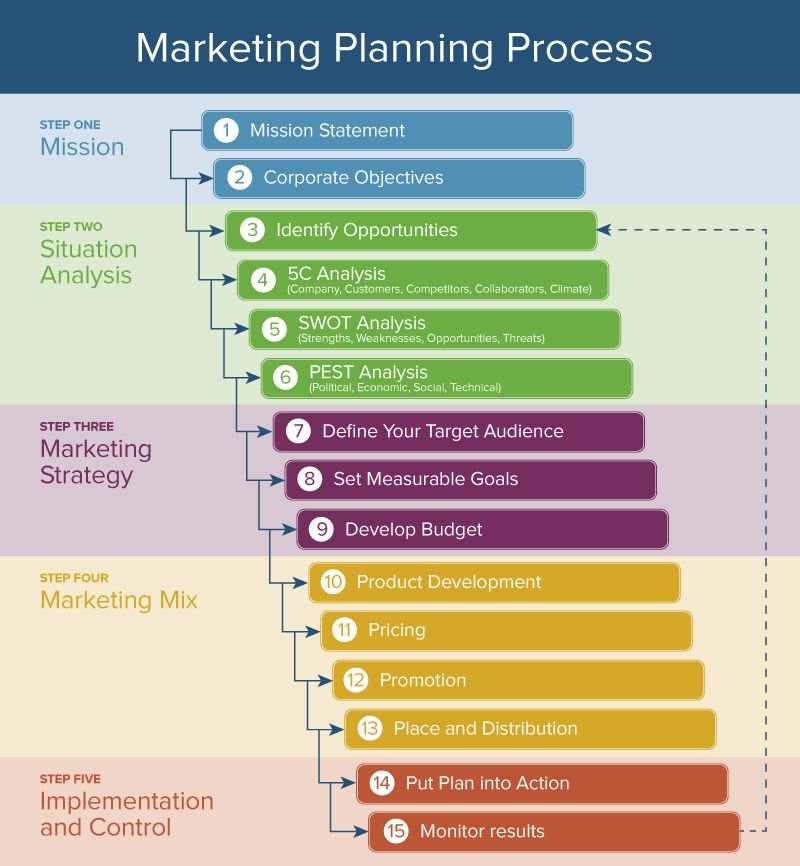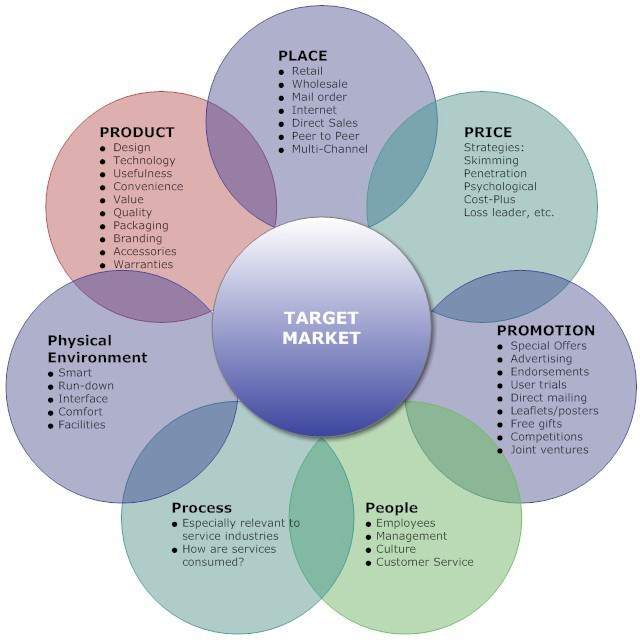The Importance of the Marketing Process
| ✓ Paper Type: Free Assignment | ✓ Study Level: University / Undergraduate |
| ✓ Wordcount: 1877 words | ✓ Published: 12 Aug 2019 |
The Importance of the Marketing Process with Particular Regards to the Relationship between Marketing Objectives and Marketing Tasks
Introduction
In this paper, I am going to illustrate the difference between tactics and strategy by investigating the characteristics of marketing process and the role that they play. I will present a clear understanding of the concept of marketing plan and what distinguish strategy from tactics. This will demonstrate difference between those two based on essential strategic activities. My research will examine the importance of the ‘marketing process’ and how this affect an organisation’s ability to create added value for its stakeholders. I will show the theoretical framework and illustrate by analyzing a UK based pension and investment powerhouse, M&G Prudential.
M&G Prudential (M&GP) was formed in 2017 after an internal merger between Prudential’s two UK based businesses, Prudential UK and Europe, which was life insurance company and M&G, an asset management business. Prudential has been a market leader with a largest life insurance offering in the UK market, on and off, since it was formed in 1848. Aviva, Aegon and Standard Life, are the other top life insurance brands in the same market space that are competing for a similar market share. As the business is going through unprecedented change, the strategic objectives and the marketing plan, are more than ever crucial for M&GP to be successful in the competitive global market.
It is imported to understand, that in business, strategic planning will come first as it will dictate the long term direction of which the business wants to grow in relation to the competitors. Marketing planning follows the strategic path set out at the corporate, business and operational level of the organisation.
In this paper I will refer to marketing strategy as the overall concept, who’s aims are long term, more then 12 months, which focus are the goals and the objectives of the company.
Tactic is the effort via which the strategy is executed. Those are short term actions, less then 12 months, which add up to achieving the strategic objectives.
Successful marketing strategy can help the business stay one step ahead of the competition and to be ready to respond and take advantage of changes ahead.
Marketing Planning Process
Marketing plays an important role in any business. It would be impossible to attract and keep clients without marketing. To make a real difference in today’s market, an organisation needs a comprehensive marketing plan. Such plan should never be prepared and used in isolation and should be based on the corporate objectives of the organisation’s which are identified by the company business plan.
An effective marketing plan will have both, marketing tactics and marketing strategy, which work in synergy and complement each other to give the best result that support the overall business strategy (see appendix 2).
A well structed marketing plan should have clear and realistic target which can be confidently achieved. The plan should also include:
- Company’s current position, direction and priorities
- Understanding of position in relation to external factors and against the competition- Macro environment
- SWAT analysis of company’s strengths, weaknesses, opportunities, and threats
- Understanding of the micro environment – demand and supply theory
- Clearly defined objective and how they will be benchmarked and how the success will be measured
- A method for regular checks on progress and results against benchmarks
- The resources to achieve business objectives, including the finances
- Action plan and responsibilities by product or service, function and market segment – necessary details on the tactics that help to translate the strategy into action
- The marketing Mix (4Ps or 7Ps) and STP (segmentation, targeting and positioning)
The Segmentation, Targeting and Positioning Model (STP)
Segmentation, Targeting and Positioning (STP) is one of the most frequently applied marketing model.
The STP model is beneficial when creating marketing communications plans as it helps to prioritise, develop and deliver tailored and appropriate messages to engage with different audiences.
In addition, STP attention is on profit-making effectiveness by selecting a segments for a business where it gets the best value and then develop a marketing mix, followed by product positioning strategy for each segment.
STP is also relevant to digital marketing through which channels new options are available for targeting customers that were not available previously. You can easily compare products you are interested in, which can create interest-based targeting opportunities, example of which can be a very popular in the UK website, www.moneysupermarket.com, where you can find number of offerings from mobile phone, to life insurance or any other money savings options.
M&G Prudential has been monitoring the trends and using digital media tactics to understand the customer needs and how its position in the market segment. Facebook, Twitter interactions, blogs and forums are analysed for trends for M&GP as well as the competition (see appendix 3).
Another targeting tactic would be an email or onsite personalisation which is based on customer profile, his behaviour. There are many new opportunities for brands to interact with clients via digital tools including apps and tailor the content accordingly to customer needs.
Additionally, using STP trough segmentation, can help identify niches with particular requirements, more mature markets can uncover new customers base, and deliver more bespoke and focused marketing messages. Each marketing segment should have appropriate marketing messages as when it comes to customer types there is no one size fits all. For organisation like M&GP this would be best applied when looking to discover new market rather than trying to find a niche in the market. This is a great tool for the business to analyse current position it holds against the competition and to identify new opportunities.
Marketing Mix Tactics
The marketing mix will create the tactical steps to carry out the strategy and to reach the target market. By developing and implementing those techniques the tactical steps will turn the strategy into a reality.
Understanding and applying the marketing mix 4Ps – Product, Price, Place, Promotion or 7Ps, which additionally looks at -People, Process and Physical location, is essential for the organisation to be able to fulfill its long term strategic objectives (see appendix 2).
M&GP Swot Analysis
Strengths – Very solid Market Place in Asia, Europe and the U.S. Having all of the three most appealing savings markets can provide a competitive edge to the Group global. This supports the business to hold to existing customers and also to draw the new ones in. Prudential Plc has continuously undertaken to constantly improve its brand value by focusing its marketing strategies depending on the market.
Weaknesses – Excessive operating costs poses a danger of reducing profit margins for the company. M&GP offer similar products to other life insurance companies, so making sure that commercial attractiveness for each product is well assessed is crucial.
Opportunities – Expansion in EU might help to rise the company’s profile and bottom-line profits.. Reports are showing that the market for retirement products is now the major driver of growth in financial services. This change could profit the life and pension business of the M&G Prudential.
Threats – Presence of global namesakes, one being Prudential Financial Inc, riddles clients and can therefore do some harm to the well know business. The merger and uncertainty of the business can create loss of talent while the organisation goes through a transformation stages. Investment in the technology could introduce identity theft and need to be closing monitor. Regulatory changes like GDPR will impact how much information can be sampled to be able to build customer profile to better understand customer behaviour.
M&G Prudential Case Study – Analysis of Long-Term and Short-Term Orientation
M&G Prudential ambition and strategy for the business have been declared by John Foley, Chief Executive of M&G Prudential, “The demerger will allow M&G Prudential to play a broader leadership role in the fast-changing savings and investments market within the UK and Europe. M&G Prudential’s proven investment capabilities and balance sheet management provide an excellent platform from which to serve the demand for comprehensive financial solutions.”
Throughout my research I discovered number of long term initiatives and tactics which are being utilised to transform the organisation into much more modern and technology savvy company which can compete with other players in the market. The recent merger initiated a numerous transformational programmes which aims are long term cost savings, including technology upgrade, change of location, customer upgrade, and skills upgrade.
One of the M&GP long term strategies is to try to break into the advice industry by investing and introducing a new and ambitious recruitment programme that will help the organisation to expand services and also supports new talent, introduction a new generation into the brand. The short term steps are to recruit and train up staff to become a fully-fledged advisers.
On a macro-level we can see huge changes which M&GP has taken into account, those are globalisation, deregulations of the markets, and individualisation of the customer. M&GP as a global brand has location-specific and target-specific marketing in place. With the Brexit, a new threat has been introduced to the business, which has been addressed and new offices in EU have been created. This can generate many new opportunities and an expansion of the into continental Europe.
Furthermore, there is enough evidence to see marketing mix being applied when it comes to brand awareness. From Prudential Ride to M&G Flower Show or M&G Ski the brand gets exposed into markets that it would not necessary have access to otherwise.
By understanding the theory of lifecycle we can predict that with the raising costs of technology changes, bad debts, new product development costs, media spending etc. it is essential for the organisation like M&GP to stay profitable it needs to become more effective as generalists.
Conclusion
If it uses technology cleverly, instead of relying wholly on expensive brokers to bring in new business, and it taps the world’s capital markets intelligently, it can haul itself into the 21st century. Its members have to choose between their past and the future and do so quickly.
It could not do so fully, but technology could link the underwriting brains at its heart to a global distribution network more efficiently than its brokers care to admit.
History gives it an origin story and a global brand, but holds it back. Many of its brokers still transact deals on paper, rejecting the technology.
In a decade, Lloyd’s could be an open market for underwriting, with contracts sold directly on a global platform and brokers involved only when they add expertise, rather than simply expenses. Or it could stick with bells, quills and fees. The answer is clear.
References
- Marketing by Masterson et. al (2017)
- Lancaster G. and Massingham, L. (1988) Essentials of Marketing. Maidenhead, Berkshire, England. McGraw-Hill.
- Smith, W. R. (1956). Product differentiation and market segmentation as alternative marketing strategies. Journal of Marketing. (Vol. 21, Issue 1, July). p3-8.
- https://www.professionalacademy.com/blogs-and-advice/stakeholder-mapping—marketing-theories
- https://www.smartinsights.com/marketing-planning/create-a-marketing-plan/structure-effective-marketing-plan/
- https://www.mandg.com/about-us/responsible-investment/
- https://www.professionalacademy.com/blogs-and-advice/stakeholder-mapping—marketing-theories
- https://www.ft.com/content/a321d642-dc38-11e8-8f50-cbae5495d92b
Appendix 1
Marketing Planning Process

Appendix 2
Marketing Mix – 7 P’s

Cite This Work
To export a reference to this article please select a referencing stye below:
Related Services
View allDMCA / Removal Request
If you are the original writer of this assignment and no longer wish to have your work published on UKEssays.com then please click the following link to email our support team:
Request essay removal


